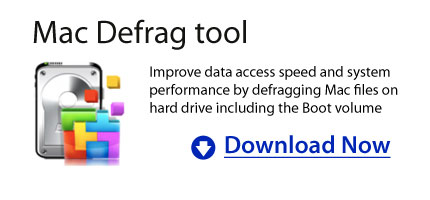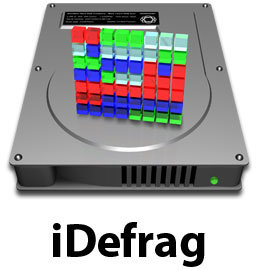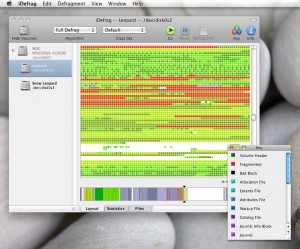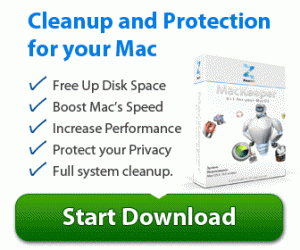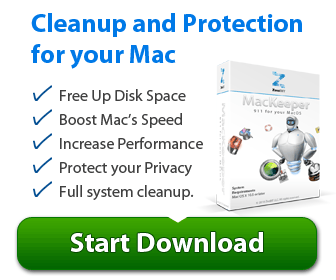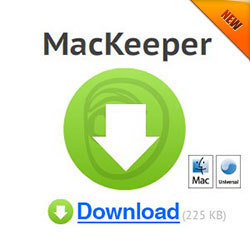Defragging Mac Hard Drive? Do it with iDefrag
April 12, 2011
Mac users know that they don’t have to worry about defragging a Mac hard drive. This is because the Mac system itself is built in with routine maintenance capable of handling fragmented files automatically. But doing a defragmentation process can quite helpful in making the system performance speed up and improve as well. This is where iDefrag third party defragging software comes in.
The Mac OS X has its own HFS file system that puts all the files altogether in the hard disks. Even if does not grouped all the files together for quicker access but it offers better space at the start and end of the disks allowing the files to expand easily on its size without the need for undergoing a lot of fragmentation. This is applicable on large disks that has greater space does defragging is not necessary at all.
However this does not mean that the HFS file system does nit experience file fragmentation because in the long run this can happen when the disk is getting full of stored files and at the same time is already running out of space. If Mac users are constantly creating and deleting large files, the space between the disks soon adds up and files will end up getting fragmented. This is where the system needs to have defragging too to shrink all these large files and organized it better.
When it comes to degragging Mac, one of the leading defragging tools is the iDefrag. It has two parts. This is the general interface and the other defrag interface run during the booting process. If you intend to defrag Mac OS make sure that you are not using the system itself. The general interface of iDefrag is quite simple and easy to use. Once the application is run, select the disk that you want the defragging process to take place. It will show a list of files where it is located and the amount of fragmentation. Then finally click on the final step in defragging the disk. Once done an improved system performance will result from it.
The applications have its info pane where are shows the exact file name, including its size, location and other details regarding the files. But be aware that the defragging process can take a long time to run. So it is a protocol also to backup all your important files in case the software will fail during the defragging process. But in the end, you can expect that the application is really good at a decent price offering of $37. The program itself uses different defragging algorithms, support hot file zone, and monitors the hard disk temperature and a lot more.
The next time you what to consider defragging Mac hard drive, it is just right to do it anyway because this can be beneficial for the Mac system itself. When it comes to selecting a defragging tool, one of the name catching up on the list is the iDefrag that is capable of defragging and optimizing the Mac system.
iDefrag: A Mac Defrag Freeware
April 10, 2011
If you are frequently using you Mac over time you will notice that the Mac system slows down. This is quite true if your one of the Mac users that constantly run security updates replaces operating systems components and creates and deletes large files. Chances are you are increasing files that are fragmented in the hard disk and even degrading the performance of Mac system. One of the solution to these is using Mac defrag freeware that will defrag the hard drive and improve the system performance in the process.
If you’re looking for defragging software for Mac OS X, here’s one of the available defrag freeware that you can download readily:
iDefrag Mac Defragger
iDefrag solves fragmented files in the hard disk by defragmenting and optimizing the file system of Mac in the process. It has the following features and capabilities:
- Defrag individual files: Allows you to select and defragment individual files without affecting the rest of the hard disk.
- No need for bootable CD/DVD: All you need to do is click the Go options and iDefrag will reboot automatically the machine into special mode and run the defragging process without the need for separate boot disk.
- Improved performance: It is packed with performance tweaking routines that speed up the Mac system.
- Improved user interface: It has easy to use and understand user interface that has reduced cluttered options and improved accessibility for users.
- Full support the Mac OS X Snow Leopard: It works well with the Mac OS X latest version and even the Apple’s latest hardware specifications.
- Works with Time Machine: it is even safer to use with the Time Machine back up.
- Supports the journaled file systems: It supports the journaled file system and knows how to deal with it automatically. You don’t need to turn off the journaling in order to defrag or optimize the hard disk.
- Supports HFS+: It deals with the case sensitive HFS+ too for compatibility with the UNIX software.
- Supports Hot Zone: It supports the hot zones and places the files to the right location.
10. Thermal Monitoring: While defragging the hard disk the iDefarg application will monitor also the temperature of your disk. Once it is already warm, the application will have to wait for the disk to cool down before proceeding to defragging process.
11. Uses powerful defragmentation algorithms: You can either choose optimize or compact disk if you want to optimize the Mac system and rearrange the files in the hard disk.
12. Defragment the disk even if it is in use: It can even run simple defragmentation process even if the disk is still in use.
13. AppleScript and Automator Support: It also supports AppleScript and has Automator action without the need to learn about AppleScript while defragging the process.
iDefrag is simply one of the recommended Mac defrag freeware that is capable of tweaking the performance of your Mac system, defragging the files in the hard disk and reorganizing everything. All you need to do is wait for the process to take off and you will see an improve performance of the Mac system afterwards.
Incoming search terms:
Defrag Macbook: How to Do It?
April 6, 2011
When large files are created and deleted frequently chances are they become fragmented and even results to slow down of Mac performance. If this happens it’s about time to defrag Macbook and you can do this by either using third party defragging applications or doing it the manual way which is quite risky.
Defrag MacBook with Third Party Applications
The newer versions of Mac operating system has already built in routine techniques that is needed in optimizing the hard disk. It uses the HFS+ (Hierarchical File System Plus) that defrags the hard disk automatically. No matter how frequent you create and open files it has great impact to the file system performance. Once the Macbook slows down its performance then chances are this is already fragmented and even degrade the whole Mac system performance.
It is quite recommended to defrag Macbook when the operating system already slowed down. Although the Apple Company doesn’t recommend the necessary applications that will defrag the hard disk but with the wide variety of third party software you can choose which one will deal with defragging process effectively. There are several companies that offers defragmentation applications for Macbook system itself. One of the recommended tools for Mac is the iDefrag. This can be downloaded readily from the developer’s site and is offered at a price value of $35.00. But then you can try its trial version also and see what it can do to your Macbook system. This applications is quite easy to use and even scan the hard disk before determining whether you need to defrag the Mac system or not.
Once the iDefrag application is installed in the Mac, it is needed to create the boot disk with the use of CD, then boot from the disk to run the iDefrag applications. Once running it will scan the hard disk and start performing the defragging process. You can choose from the different algorithms offered by the application from Compact, Full, Quick, etc. Once the defragmentation is done, restart the Mac and you will see an improve performance afterwards.
Other Ways to Defrag Mac Disk
If you have slow down Macbook performance but don’t want to purchase third party applications to defrag the hard disk, you can try alternate ways to defrag Macbook and this can be done by:
- Backing up all the important data then installing again the Mac OS X and then install and recover all the files back to the hard disk. But doing this can take a longer process.
- Back up all the files from the hard disk to external data storage such as USB or hard disk. Then trash the files in the Mac. And then retrieve back the files from external drive back to the Macbook.
Once the Macbook is getting slow on its performance this will tell you that the Mac system is already fragmented. It is quite recommended to defrag Macbook and you can either do this manually by backing up all the files in the hard disk and reinstalling the Mac OS X and the other is installing third party applications that perform defragging process. The latter process is quite recommended way to do it.
Incoming search terms:
iDefrag Mac
March 29, 2011
The Solution to Defrag Your Mac’s Hard Drive?
When you’re a Windows platform user you need to pay attention to defragmenting hard drives, installing antivirus applications and firewall applications as well. However if your into Mac system you don’t need to pay attention to all of these. But this does not mean that you don’t need to defrag Mac’s hard drive using iDefrag Mac application.
Mac system is already known to be built with maintenance routines that are update more often thus allowing users to have lesser problems on tweaking its performance. When it comes to defragmenting the Mac system one of the best recommended tool is the iDefrag. Here are some features regarding the applications, go through it and reflect whether you need it or not.
Do you need to Defrag Mac System?
For Windows users defragging the hard drive is needed in every few months. This can be disappointing at times because even the built-in defragging software took several hours to finish the defragging process. Most new to Mac system might wonder if they need to defrag their Mac and how they can do it. Most people would tell them that it is not really needed at all. However, even the Apply Company itself sees the importance of defragging the Mac system. The iDefrag Mac applications have been around few years back and have been known already fro defragging the Mac hard drive.
iDefrag Defragging Tool for Mac
iDefrag have its trial version and can be readily downloaded from its developer’s site. The trial demo version has a limited features but it can actually offer what it can do to the system. After downloading and installing the applications you will see the available volumes on the left pane. You can’t make any changes to the drives until you enter the Administrator password.
Then click the lock icon to authenticate and verify the password. Once done, the application will start scanning the drive and then on the right pane it will show the drive’s content. The visual linear graphic at the bottom panel will tell you if the drive is already in good shape.
Once the defragging process took place you will notice that most of the fragmented files are sorted out and the Mac system will be running faster at this time. You need to select the five defragging Algorithms offered by the iDefrag tool from the pull down menu located at the toolbar. You can select Compact, Quick, Optimize or Full Defrag options from the given options.
Just remember if you choose to defrag your Mac hard drive be aware that files that are stored in different locations can be moved. And in case if anything goes wrong you need to perform a full back up first with your files.
iDefrag Algorithms
If you wish to defrag your Mac startup volume it is needed that you restart first the computer to complete the Quick algorithm options. The Full Defrag is the common option to do in defragging the system. It is already a combination of Metadata and Optimize algorithms. The Metadata algorithms deal on the volume metadata and the adaptive hot file clustering system while the Optimize algorithm deals in the disk optimization options and rearranges the files on the disk. The iDefrag tool will eventually boot the machine in a special mode while doing the defragging process.
Although some people would advice you that you don’t need to defrag the Mac system but doing it might be helpful at all. Running defragmentation process will eventually boost the Mac performance. So when it comes to defragging Mac hard drive you can rely on iDefrag Mac applications.
Incoming search terms:
Defrag Mac with iDefrag Tool
March 19, 2011
Been worried about your Mac performance? Did your applications take longer to open and close or you files are quite hard to locate? All of these are causing problems in your Mac system and defragging this can be the solution. There are a lot of defragging tools that you can choose for your Mac and one of the recommended tools that are catching up on the list is the iDefrag. Want to know more about this defragging tool? Here are some features that might indulge you to try this application for your Mac system.
Over time ad you constantly update your security and replace your operating system, chances are you are also increasing the chance that your files will be fragmented. This leads not only to slow Mac performance but will clutter your hard drive disk also. The iDefrag can check for the fragmented files in your hard disk, defragment these files and optimize the overall performance of Mac system. The following features of iDefrag are the following:
iDefrag application supports both the HFS and HFS+ as well ad sensitive and journaled files systems amd even the adaptive hot file clustering. This also uses powerful defragging algorithms including Compact data where it allows you to move all the available free space into one location, enhances the filesystem metadata, defragmentation through online, even if the disk is mounted defragment whilst is still possible, programmable optimization and arranges the hard disk according to your preferences.
It is also supported with B-Tree metadata file compaction and optimization. It uses high performance user defined engine for file classification and display also the whole disk lists. It also shows graphic and detailed statistics that will help you determine when you need to optimize your disk. The Inspector tool will show all the details of individual files in the hard disk and you can easily go to specific files that you want to examine in detailed. It is also built with auto-update feature so that you will always get the latest version of the application. And it has fined grained security features and supported by AppleScript.
The new added version of iDefrag can also fixed bug problems that might cause the application to stop during the defragging process once the errors are detected. It can also fix a minor fault when resizing the iDefrag window pane and even resolve the problems when installing the codes that might fail to restart properly once the installation is done. The application requires PPC and Intel as well as Mac OS X with 10.5 versions or lower. And lastly the application is capable of thermal monitoring that will tell you the temperature of your hard drive that can cause slowed Mac system performance when it is already warm.
This time if you are considering to defrag Mac, I think it will be best to try and install iDefrag applications in your Mac system. It comes with advance features that ensures that your files are defragmented causing to speed up and improve your Mac performance in the process.
Defrag Mac with iDefrag: Is It Really Needed
March 17, 2011
Over time as you use your Mac system, the performance of it tend to get slower. This can resolve by defragging the hard disk drive with the right software tool that is capable of doing that too. But some Mac users often wonder if they really need to defrag Mac? Before you download and install some defragging applications in your Mac why not consider these helpful tips too.
Do Mac systems need to defrag the hard drives? This really depends. You need to consider first why your Mac has slower performance and what you can do about it. Often times as you use your Mac OS X and perform multiple backups, install applications everyday and save files in the hard drive you will notice that the system has degraded its performance. This can really cause the slower performance of the Mac system. Some applications will take longer before it opens and closes. Some might consider that the fragmentation is the main problem of this.
As Mac users you would often consider defragging as the solutions. But before you does this try some other measures to check what you can do first with your Mac hard drive. Create a solid backup first with other external devices and make sure that all files are being backed up. And then select from the different defragging tools that will work on Mac hard drive. You can choose from iDefrag, Drive Genius and a lot more.
Considering to do back up, removing files in the disk drive, installing again the Mac OS X and other applications and then restoring the files again in the system can quite a tedious job before your Mac will run faster. But with iDefrag improving the performance of Mac is quite easy. It allows you to select the files that you want to defrag and it don’t require a bootable CD or DVD to make it work. It also controls the HFS Plus and even monitors the temperature of the Mac drive that can also slows down your system if it gets warm too.
Another thing that iDefrag can do is check the individual sections on the hard disk, view the changes that has been in real time and uses different defragging algorithms in order to optimize the hard disk and most of all you can rearrange the files according to your preferences. You can do this simply by running the iDefrag, and then select the disk that you want to defrag; select either Full Defrag and Default defragging algorithms and then click go. The application also check the hard disk, display the list of files that are fragmented and click which files you want to defrag.
Before considering to defrag Mac you need to look first what cause the slowed performance of your Mac system. Usually files that have been cluttered in the hard disk and applications that are installed in the system is the main culprit of the problem. One way to resolve this is creating back up copy in external devices and re-installing the Mac OS. This is quite a risky thing to do because some files may be lost during the process. But when you choose to select the right defragging tool that will defrag your Mac OS effectively then this is much better solution. When it comes to defragging files in hard drive the iDefrag is one of the recommended tool for you system so better try and download it now!
